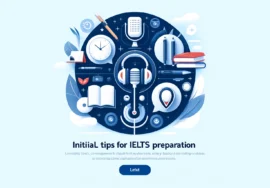
Ace the IELTS Listening Test: Tune In and Score High!
Prepare for the IELTS Listening Test with this comprehensive guide! Discover the format, question types, active listening techniques, and strategies to master different accents and manage time effectively. Ace the test and achieve your desired band score!
Ace the IELTS Listening Test: Tune In and Score High!
The IELTS Listening test is an opportunity to demonstrate your ability to comprehend spoken English. But it requires more than passive listening; it demands active engagement with the audio to extract essential information. Imagine it as a detective mission – listening carefully, picking out clues, and solving the puzzle of each question. With the right preparation and approach, you can transform this challenge into an opportunity to shine. This comprehensive guide will equip you with the skills and strategies to master the IELTS Listening test and achieve your goals.
Understanding the Format: Four Sections, Increasing Difficulty

The IELTS Listening test consists of four sections, each with 10 questions. The difficulty escalates as you progress:
- Section 1: A casual conversation between two people in an everyday setting, such as booking a hotel room, discussing travel plans, or arranging a service appointment. The language here is straightforward and often involves exchanging personal or transactional information.
- Section 2: A monologue in a social context, like a tour guide explaining a museum exhibit, a public announcement about community activities, or a speech at an event. The focus here shifts slightly toward a more formal style.
- Section 3: A conversation involving up to four people in an educational setting, such as students working on a group project, discussing research topics, or a tutor explaining an assignment. This section often includes academic terms and requires careful listening to multiple speakers.
- Section 4: A monologue on an academic topic, such as a university lecture or a presentation on a specialized subject. This is the most challenging section, demanding attention to detailed explanations and specific terminology.
Be prepared for a variety of accents – British, American, Australian, Canadian, and others – as the test reflects the global use of English. Exposure to these accents during practice will greatly enhance your confidence and performance.
Question Types: Know What to Expect
Familiarity with question types will help you tackle the test with confidence. The IELTS Listening test includes the following formats:
- Multiple Choice: Select the correct answer from a list of options. Some questions may ask you to choose more than one answer.
- Matching: Pair specific pieces of information from the audio with the corresponding options provided in the test. This type requires careful attention to details and relationships between ideas.
- Sentence Completion: Fill in blanks in sentences using words directly from the audio. Ensure spelling and grammar accuracy, as mistakes here can cost you marks.
- Form/Note/Table/Flow-Chart Completion: Complete structured content by adding details from the audio. These questions often test your ability to extract key facts and figures.
- Short-Answer Questions: Provide brief responses based on the audio, often requiring you to write within a word limit. These answers should be concise and precise.
Understanding the nuances of each question type will help you strategize effectively and avoid common pitfalls during the test.
Active Listening Techniques: Sharpen Your Ears

Effective listening requires a strategic approach. Here’s how you can fine-tune your skills:
- Predict the Content: Before each section, use the preparation time wisely by reading the questions. This helps you anticipate the topic, context, and possible vocabulary that might appear in the audio.
- Identify Keywords: Pay close attention to keywords in the questions. These words often signal critical information in the audio. Look for synonyms and paraphrased expressions as speakers rarely use the exact words in the questions.
- Focus on Main Ideas: Instead of trying to capture every detail, aim to understand the overall message and main ideas presented in the audio. This approach will keep you from getting lost in minor details.
- Practice Selective Note-Taking: Develop the habit of jotting down brief notes during practice sessions. This can help you retain important points without losing focus on the audio.
Understanding Different Accents: Train Your Ears

The inclusion of various English accents in the test can be challenging, but consistent practice will prepare you to handle this diversity. Here’s how to enhance your accent comprehension:
- Listen to Authentic Materials: Immerse yourself in diverse accents by consuming podcasts, news broadcasts, TV shows, movies, and radio programs. Pay attention to pronunciation, intonation, and regional variations in speech.
- Practice with Online Resources: Many online platforms offer IELTS listening practice tests featuring a range of accents. Incorporate these into your study routine to simulate test conditions.
- Learn Accent-Specific Nuances: Familiarize yourself with commonly used words, phrases, and pronunciation patterns unique to different English-speaking regions. This will help you better understand context and meaning during the test.
Managing Time and the Answer Sheet: Strategic Test-Taking

Efficient time management and answer sheet handling are crucial for success in the IELTS Listening test. Follow these tips:
- Time Management: Be mindful of the limited time for each section. Since there is no extra time allotted to transfer answers to the answer sheet, practice completing each section within the given time during your preparation.
- Transfer Answers Neatly: Write your answers legibly on the answer sheet. Double-check spelling and grammar, as errors in these areas can lead to lost marks. Ensure your answers match the required format (e.g., using words from the audio).
- Use Allotted Review Time: Take advantage of the short pauses between sections to review your answers and prepare for the next set of questions.
Additional Tips for Success
To further enhance your performance, consider these additional strategies:
- Simulate Real Test Conditions: Practice listening tests in a quiet environment to mimic test settings. Use headphones to focus on audio clarity.
- Analyze Practice Test Results: Review your mistakes from practice tests to identify patterns and areas that need improvement.
- Build Your Vocabulary: Expanding your vocabulary will help you understand a wider range of topics and contexts.
- Stay Calm and Confident: Anxiety can hinder performance. Take deep breaths, stay positive, and approach each section methodically.
Conclusion: Listen Actively and Conquer the Test
By practicing active listening techniques, familiarizing yourself with different accents, and adopting effective test-taking strategies, you can excel in the IELTS Listening test and achieve your desired score. Remember, success in this test is not just about understanding English but also about demonstrating your ability to engage with diverse topics and contexts. So, tune in, focus, and impress the examiners with your listening prowess. The detective in you is ready to solve the IELTS Listening puzzle and unlock new opportunities!








